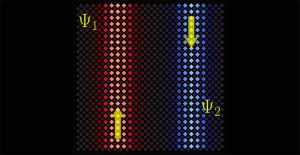Topological Insulators for quantum simulators
A recent study in reports on how the many-body interactions in topological insulators can be of great advantage for quantum simulations of complex systems.
In the last decades, topological insulators have attracted great interest and also have promising applications in topics such as metrology or quantum computation. Topology is defined as the mathematical study of the properties that are preserved through deformations, twistings, and stretchings of objects. These exotic materials go beyond the standard classification of phases of matter: they are insulating in their bulk, conducting on their edges, and characterized by a global topological invariant, in contrast to a local order parameter as in the conventional Ginzburg-Landau theory of phases of matter.
Such topological phases have been experimentally observed in condensed matter systems and more recently in quantum simulators. The latter is very versatile platforms that allow one to simulate a material with another quantum system in a very controllable environment. In the case of topological insulators, this degree of control is particularly promising to unveil the mechanisms leading to these phases.
The quantum simulation of these exotic materials typically relies on the generation of artificial gauge fields. However, recent studies have shown that topological phases can also emerge from particle interactions. The latter mechanism leads to the concept of interaction-induced topological phases, in which topology is acquired through spontaneous symmetry breaking process. The interplay of the spontaneous symmetry breaking with the global topological properties can lead to very interesting effects.

In a recent article published in Physical Review Letters and highlighted as an Editor’s suggestion, ICFO researchers Sergi Julià-Farré led by Prof. Maciej Lewenstein and Alexandre Dauphin, in collaboration with Prof. Markus Müller from RWTH Aachen University and Forschungszentrum Jülich, report how such interplay can lead to new strongly-correlated topological effects in a 2D material.
The team of researchers has shown how interactions can localize particles in the insulating bulk, leading to self-trapped polarons (interactions between electrons and ions in metals that result in a bound state). Moreover, they have also shown how the interacting nature of the topological insulator gives rise to new phases of matter, which simultaneously exhibit both rich spatial features and topological properties. Interestingly, the nontrivial topology associated with each domain leads to the appearance of protected conducting states in the bulk, localized at the domain boundaries. They also discussed the possibility of quantum simulating such phases with cold laser-excited Rydberg atoms in an optical lattice.
Reference: https://journals.aps.org/prl/abstract/10.1103/PhysRevLett.125.240601